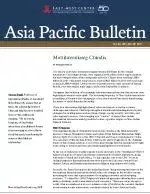Error message

The last few years have witnessed a regular stream of irritants in Sino-Indian interactions. Even bilateral trade, once regarded as the pillar of their rapprochement, has been losing its shine with a rising trade deficit in China's favor reaching US$16 billion in 2010. This deficit is expected to reach US$25 billion by 2015 with total trade at around US$100 billion. Unless the two countries explore other avenues of mutual benefit, even this modest trade target may become impossible to achieve. It is against this backdrop of increasingly lukewarm interactions that observers are now beginning to witness a new spark. Swaran Singh argues that the increasing frequency of Sino-Indian interactions at multilateral forums is fast emerging as a force that is slowly but surely transforming the nature of their bilateral relationship.
|
The last few years have witnessed a regular stream of irritants in Sino-Indian interactions. Even bilateral trade, once regarded as the pillar of their rapprochement, has been losing its shine with a rising trade deficit in China's favor reaching US$16 billion in 2010. This deficit is expected to reach US$25 billion by 2015 with total trade at around US$100 billion. Unless the two countries explore other avenues of mutual benefit, even this modest trade target may become impossible to achieve. It is against this backdrop of increasingly lukewarm interactions that observers are now beginning to witness a new spark. Swaran Singh argues that the increasing frequency of Sino-Indian interactions at multilateral forums is fast emerging as a force that is slowly but surely transforming the nature of their bilateral relationship.
|







